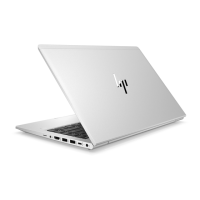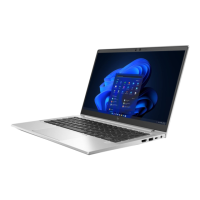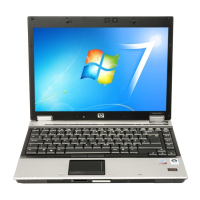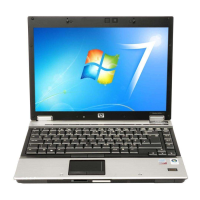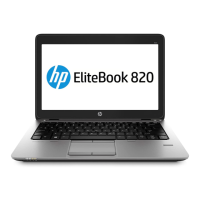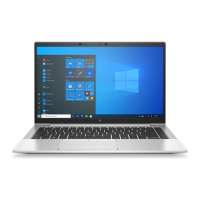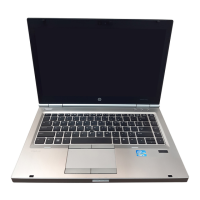Do you have a question about the HP EliteBook 640 G11 and is the answer not in the manual?
Identifies and describes components located on the right side of the computer.
Identifies and describes components located on the left side of the computer.
Identifies and describes components related to the computer's display.
Explains the display's low blue light mode for eye comfort.
Covers keyboard variations and notes about its functionality in different modes.
Details how to adjust touchpad settings and describes touchpad components.
Identifies and explains the function of the computer's indicator lights.
Explains the power button operation and fingerprint reader usage.
Identifies and describes the functions of special keys on the keyboard.
Identifies and describes components located on the bottom of the computer.
Identifies and describes components located on the rear of the computer.
Explains the purpose and location of various labels on the computer.
Provides instructions on how to determine SIM card size and insert it.
Identifies and describes ports on the right side of the computer.
Identifies and describes ports on the left side of the computer.
Identifies and describes components of the computer's display.
Notes on keyboard variations and functionality in different modes.
Explains how to adjust touchpad settings and identifies touchpad components.
Identifies and explains the function of the computer's indicator lights.
Explains power button operation and fingerprint reader usage.
Identifies and describes the functions of special keys on the keyboard.
Identifies and describes components located on the bottom of the computer.
Identifies and describes components located on the rear of the computer.
Explains the purpose and location of various labels on the computer.
Provides instructions on how to determine SIM card size and insert it.
Lists and illustrates the main computer components with their part numbers.
Details the individual parts that comprise the display assembly.
Identifies screw kits and their specifications for component replacement.
Lists various miscellaneous parts and their corresponding part numbers.
Lists and illustrates the main computer components with their part numbers.
Details the individual parts that comprise the display assembly.
Identifies screw kits and their specifications for component replacement.
Lists various miscellaneous parts and their corresponding part numbers.
Lists the necessary tools for component removal and replacement procedures.
Provides important notes and precautions to follow during disassembly and assembly.
Advises on handling plastic parts to avoid damage during disassembly.
Emphasizes careful handling of cables and connectors to prevent damage.
Outlines guidelines for safely handling storage drives to prevent damage.
Explains the risks of ESD and how to prevent damage to electronic components.
Details packaging and grounding precautions to protect components from ESD.
Describes methods and equipment for personal grounding to prevent static discharge.
Provides precautions for preparing the work area to prevent static damage.
Lists recommended materials and equipment for preventing static electricity.
Provides instructions for safely cleaning the computer's external surfaces.
Explains how to use HP Easy Clean software to disable input devices for cleaning.
Provides steps for cleaning dirt and debris from the computer's exterior.
Offers guidelines for disinfecting computer surfaces to prevent germ spread.
Provides specific care instructions for computer models with wood veneer.
Offers guidelines for safely packaging and transporting computer equipment.
Guides users on how to find HP support resources and technical information.
Outlines the steps required to prepare the computer for disassembly.
Provides instructions and illustrations for removing the computer's bottom cover.
Instructions for determining SIM card size and inserting it.
Details the procedure for removing and replacing memory modules.
Explains how to remove and replace the Wireless Local Area Network (WLAN) module.
Details the procedure for removing and replacing the Wireless Wide Area Network (WWAN) module.
Provides steps for removing and replacing the M.2 SSD from the computer.
Outlines the steps required to prepare the computer for disassembly.
Details the procedure for removing and replacing the WWAN board.
Provides instructions and warnings for safely removing and replacing the computer's battery.
Details the procedure for removing the computer's speakers.
Explains how to remove and replace the fingerprint reader board.
Provides steps for removing and replacing the SSD board.
Explains how to remove and replace the Near Field Communication (NFC) module.
Provides instructions for removing and disassembling the display assembly.
Details the procedure for removing and replacing the smart card reader.
Provides steps for removing and replacing the computer's fan.
Explains how to remove and replace the Input/Output (I/O) board.
Details the procedure for removing and replacing the computer's touchpad.
Provides steps for removing and replacing the computer's heat sink.
Guides users through the process of removing and replacing the system board.
Explains how to remove the top cover with the keyboard attached.
Methods for backing up data and creating recovery media using Windows or HP tools.
Instructions for creating HP Recovery media on a USB flash drive.
Tools and methods available for recovering the system within or outside Windows.
Explains how to create restore points for system files and settings.
Details methods for restoring the system, including System Restore and Reset This PC.
Instructions for recovering the system using HP Recovery media.
Guides on how to change the computer's boot order using the BIOS or startup menu.
Information on HP Sure Recover for OS recovery built into hardware and software.
Guide on navigating and using Computer Setup for system configuration.
Steps to return all Computer Setup settings to their factory default values.
Information on checking for and installing BIOS updates from the HP website.
Prerequisites and precautions before downloading and installing a BIOS update.
Instructions for downloading and installing BIOS updates from HP.
Steps to dynamically select a boot device using the F9 prompt.
Details on modifying Trusted Platform Module (TPM) settings for enhanced security.
Information on HP Sure Start technology for BIOS protection and recovery.
Guide to using the Windows-based utility for diagnosing hardware failures.
Explanation of 24-digit failure ID codes generated for hardware issues.
Steps to access the diagnostics tool from HP Support Assistant or Start menu.
Instructions for downloading the diagnostics tool from HP or Microsoft Store.
Guide to using the UEFI version for diagnosing hardware issues outside the OS.
Information on failure ID codes generated by the UEFI diagnostics tool.
Procedure to start the HP PC Hardware Diagnostics UEFI application.
Instructions to start UEFI diagnostics using HP Hotkey Support software.
Steps for downloading the UEFI diagnostics tool to a USB flash drive.
Procedure to download the most recent UEFI diagnostics version.
Information on using remote diagnostics features via BIOS settings.
Guide on customizing remote diagnostics settings in Computer Setup.
Details the physical dimensions and weight of the computer.
Provides operating voltage, current, temperature, and humidity limits.
Details the screen size, resolution, brightness, and viewing angle.
Provides specifications for different capacities of solid-state drives.
Instructions to restore nonvolatile memory to factory settings via BIOS.
Table troubleshooting nonvolatile memory usage and how to erase data.
Steps to reset BIOS security defaults and Custom Secure Boot Keys.
General power cord requirements applicable to all regions.
Details power cord requirements based on country or region.
Identifies and describes components located on the right side of the computer.
Identifies and describes components located on the left side of the computer.
Identifies and describes components related to the computer's display.
Explains the display's low blue light mode for eye comfort.
Covers keyboard variations and notes about its functionality in different modes.
Details how to adjust touchpad settings and describes touchpad components.
Identifies and explains the function of the computer's indicator lights.
Explains the power button operation and fingerprint reader usage.
Identifies and describes the functions of special keys on the keyboard.
Identifies and describes components located on the bottom of the computer.
Identifies and describes components located on the rear of the computer.
Explains the purpose and location of various labels on the computer.
Provides instructions on how to determine SIM card size and insert it.
Identifies and describes ports on the right side of the computer.
Identifies and describes ports on the left side of the computer.
Identifies and describes components of the computer's display.
Notes on keyboard variations and functionality in different modes.
Explains how to adjust touchpad settings and identifies touchpad components.
Identifies and explains the function of the computer's indicator lights.
Explains power button operation and fingerprint reader usage.
Identifies and describes the functions of special keys on the keyboard.
Identifies and describes components located on the bottom of the computer.
Identifies and describes components located on the rear of the computer.
Explains the purpose and location of various labels on the computer.
Provides instructions on how to determine SIM card size and insert it.
Lists and illustrates the main computer components with their part numbers.
Details the individual parts that comprise the display assembly.
Identifies screw kits and their specifications for component replacement.
Lists various miscellaneous parts and their corresponding part numbers.
Lists and illustrates the main computer components with their part numbers.
Details the individual parts that comprise the display assembly.
Identifies screw kits and their specifications for component replacement.
Lists various miscellaneous parts and their corresponding part numbers.
Lists the necessary tools for component removal and replacement procedures.
Provides important notes and precautions to follow during disassembly and assembly.
Advises on handling plastic parts to avoid damage during disassembly.
Emphasizes careful handling of cables and connectors to prevent damage.
Outlines guidelines for safely handling storage drives to prevent damage.
Explains the risks of ESD and how to prevent damage to electronic components.
Details packaging and grounding precautions to protect components from ESD.
Describes methods and equipment for personal grounding to prevent static discharge.
Provides precautions for preparing the work area to prevent static damage.
Lists recommended materials and equipment for preventing static electricity.
Provides instructions for safely cleaning the computer's external surfaces.
Explains how to use HP Easy Clean software to disable input devices for cleaning.
Provides steps for cleaning dirt and debris from the computer's exterior.
Offers guidelines for disinfecting computer surfaces to prevent germ spread.
Provides specific care instructions for computer models with wood veneer.
Offers guidelines for safely packaging and transporting computer equipment.
Guides users on how to find HP support resources and technical information.
Outlines the steps required to prepare the computer for disassembly.
Provides instructions and illustrations for removing the computer's bottom cover.
Instructions for determining SIM card size and inserting it.
Details the procedure for removing and replacing memory modules.
Explains how to remove and replace the Wireless Local Area Network (WLAN) module.
Details the procedure for removing and replacing the Wireless Wide Area Network (WWAN) module.
Provides steps for removing and replacing the M.2 SSD from the computer.
Outlines the steps required to prepare the computer for disassembly.
Details the procedure for removing and replacing the WWAN board.
Provides instructions and warnings for safely removing and replacing the computer's battery.
Details the procedure for removing the computer's speakers.
Explains how to remove and replace the fingerprint reader board.
Provides steps for removing and replacing the SSD board.
Explains how to remove and replace the Near Field Communication (NFC) module.
Provides instructions for removing and disassembling the display assembly.
Details the procedure for removing and replacing the smart card reader.
Provides steps for removing and replacing the computer's fan.
Explains how to remove and replace the Input/Output (I/O) board.
Details the procedure for removing and replacing the computer's touchpad.
Provides steps for removing and replacing the computer's heat sink.
Guides users through the process of removing and replacing the system board.
Explains how to remove the top cover with the keyboard attached.
Methods for backing up data and creating recovery media using Windows or HP tools.
Instructions for creating HP Recovery media on a USB flash drive.
Tools and methods available for recovering the system within or outside Windows.
Explains how to create restore points for system files and settings.
Details methods for restoring the system, including System Restore and Reset This PC.
Instructions for recovering the system using HP Recovery media.
Guides on how to change the computer's boot order using the BIOS or startup menu.
Information on HP Sure Recover for OS recovery built into hardware and software.
Guide on navigating and using Computer Setup for system configuration.
Steps to return all Computer Setup settings to their factory default values.
Information on checking for and installing BIOS updates from the HP website.
Prerequisites and precautions before downloading and installing a BIOS update.
Instructions for downloading and installing BIOS updates from HP.
Steps to dynamically select a boot device using the F9 prompt.
Details on modifying Trusted Platform Module (TPM) settings for enhanced security.
Information on HP Sure Start technology for BIOS protection and recovery.
Guide to using the Windows-based utility for diagnosing hardware failures.
Explanation of 24-digit failure ID codes generated for hardware issues.
Steps to access the diagnostics tool from HP Support Assistant or Start menu.
Instructions for downloading the diagnostics tool from HP or Microsoft Store.
Guide to using the UEFI version for diagnosing hardware issues outside the OS.
Information on failure ID codes generated by the UEFI diagnostics tool.
Procedure to start the HP PC Hardware Diagnostics UEFI application.
Instructions to start UEFI diagnostics using HP Hotkey Support software.
Steps for downloading the UEFI diagnostics tool to a USB flash drive.
Procedure to download the most recent UEFI diagnostics version.
Information on using remote diagnostics features via BIOS settings.
Guide on customizing remote diagnostics settings in Computer Setup.
Details the physical dimensions and weight of the computer.
Provides operating voltage, current, temperature, and humidity limits.
Details the screen size, resolution, brightness, and viewing angle.
Provides specifications for different capacities of solid-state drives.
Instructions to restore nonvolatile memory to factory settings via BIOS.
Table troubleshooting nonvolatile memory usage and how to erase data.
Steps to reset BIOS security defaults and Custom Secure Boot Keys.
General power cord requirements applicable to all regions.
Details power cord requirements based on country or region.
| Audio | Dual stereo speakers, dual array microphones |
|---|---|
| Display | 14 inch diagonal, FHD (1920 x 1080), IPS, anti-glare |
| RAM | Up to 64GB |
| Storage | Up to 1 TB PCIe NVMe SSD |
| Graphics | Intel Graphics |
| Operating System | Windows 11 Pro |
| Wireless | Wi-Fi 6E, Bluetooth 5.3 |
| Ports | HDMI 2.1 |
| Battery | 3-cell, 51 Wh Li-ion |
| Security | fingerprint reader |



